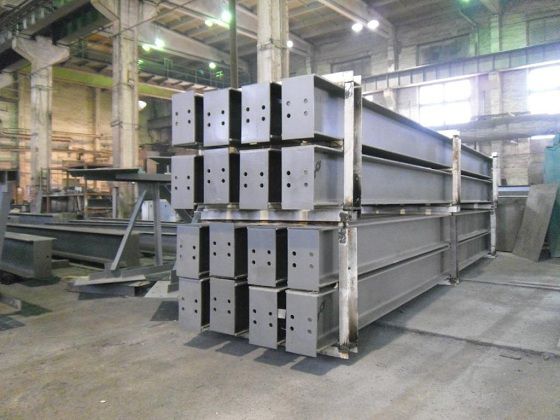Welded and castellated beams, trusses, columns

There is a wide range of products in comparison with rolled beams: it includes such steel grades as ст.3сп/пс, ст.09Г2С-12, 10 ХСНД, 390, 690. Their length can be from 3 to 18 meters. These are unique beams with the web of variable cross-section. Ultrasonic quality control for weld joints. We accept shop orders for welded beams of different types: according to a customer's drawing, in accordance with the dimensions adopted for rolled beams according to the GOST or TU standards, as well as for beams of non-standard design. The notion of "welded beam" includes a wide range of products manufactured by different manufacturing technologies.
Compound welded I-beams with parallel and inclined sides are used in building structures, bridges, overpasses, hydraulic structures. In building structures beams are present in beam grids designed to bear loads and transfer them to columns and walls. In more complex beam grids, compound beams play the main role, and rolled I-beams are used as joists and floor girders. Compound beams are oriented along the bay and located in the beam grid with a certain pitch between columns in the perpendicular direction.
You can order the production of a welded beam or buy finished products of the following designs:
• compound beams welded made of an iron sheet, a strip bar, angles, T-shapes;
• light beams with the flexible web;
• beams with the corrugated web;
• castellated beams welded from an I-beam longitudinally cut in a certain way;
• bi-steel beams made of steel grades of different strength, in which high-strength steel is used in stressed areas of the I-beam chords, and steel of lower strength is used in areas bearing normal stresses.
Beams with flexible webs are designed with a thin (in comparison with a standard one) web and stiffening bars located at a certain calculated distance. The work of such beams resembles the work of a truss frame in which stretched sections of the I-beam web play the role of tension diagonals, and compressed columns serve as stiffening bars, so the beam can bear the declared load, and its use in building structures allows to reduce the metal consumption.
Beams with the corrugated web offer reduced metal consumption in comparison with conventional beams, good local stability and torsional stiffness. Light beams with the corrugated web are I-beams, the walls of which are made of molded sheeting (with trapezoidal, rectangular, corrugated, triangular corrugations), connected by automated welding with a continuous, full-strength weld with band-iron chords. Beams with the corrugated web are widely used in bridge building, construction of industrial and residential buildings, hangars, and warehouses. They work well for bending and are used as joists, floor beams, gantry beams, and as elements of columns and frame legs operating under the influence of normal loads.
